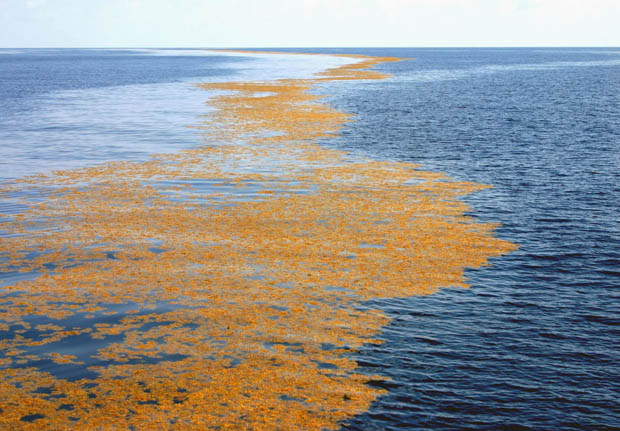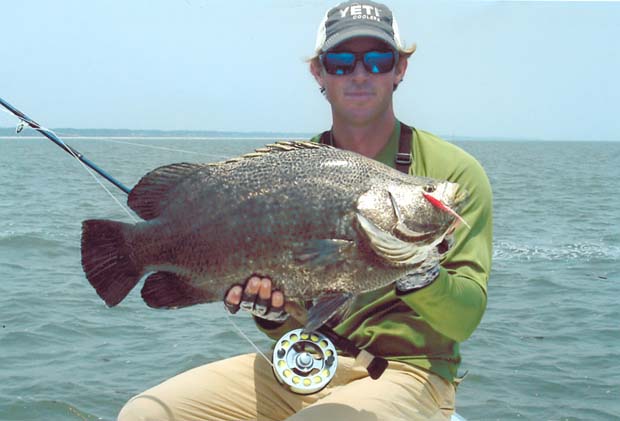
Photo courtesy of Guy Harvey’s The Online Fisherman.
[dropcap]I[/dropcap]f you fancy fish for a meal, here’s a good tasting one, the tripletail. I personally find the creatures fascinating and a legitimate tussle on an 8-weight fly rod (for sight fishing use a floating line, a reel with a good drag system, and you won’t need more than 150-yards of 20-pound test backing). And yes, they’re acrobatic and can perform multiple jumps while engaged. Their runs, although short lived, are powerful. The maximum weight is about 40-pounds and 3-feet long, but I’ve never caught one over 20-pounds in Florida.
Florida
In the spring, tripletail concentrate just offshore at two hot-spots; Port Canaveral, Florida (March–June, 20-to-30-pounders not unusual) and Jekyll Island, Georgia (April–July). May is prime throughout its southern realm. The entire Gulf has tripletail all spring and summer. Although they have been caught in some years as far north as Massachusetts, they’re rarely found north of Chesapeake Bay. They’re migratory and considered pelagic.
They can be found in bays, sounds, and estuaries during the summer. Juveniles are usually found swimming under patches of Sargassum, near shipwrecks, or support beams, jetties, flotsam and sea buoys. In the Gulf, adults can be found in open water, but they will also frequent passes, inlets, and bays near river mouths. The big boys are usually way offshore in open water, but no matter where found they will always be next to floating objects. In the Panhandle waters, spring and fall can be productive times, but inside and outside Apalachicola Bay, August and September can be excellent. The fish can be found near shore, around the sea buoys, and offshore under floating debris.
Stone crab season opens in October and tripletail will usually be hanging on the down-tide side of trap floats. In Florida Bay anglers search for trap floats and when a fish is spotted, circle back and approach quietly to present your fly.

Pelagic Sargassum weed line, home and hunting grounds for many species, including tripletail – photo Rosenstiel School of Marine and Atmospheric Science.
When handling be wary of their gill plate covers, they’re razor sharp
The same approach is used in Everglades National Park and near-shore park markers off the Ten Thousand Islands. You can blind cast at a marker and get lucky with a fish a few feet under the surface, but I wouldn’t spend more than a few tries at it. Too, you’d need at least 9-weight to manage heavier get-down flies. Use a shock tippet of at least 40-pound mono or fluorocarbon because of the razor sharp gill plates. If you’re IGFA rigged, don’t go under 15-pound class tippet.
Flies used are streamers – green and white glass minnows, crabs and shrimp imitations with some brown grizzly feathers on the latter. And, as usual, bright flies on sunny days and dark flies on a darker overcast day. Up to 1/0.
Approach with stealth and you’ll need to be a good caster – able to hit at least 65-feet or better. The fly can be made to drift into the fish’s window of opportunity so cast considerably away from the targeted prey. When you get hooked up, set the hook with zeal. You can hit the thing on the head and get an eat also. Their tendency to follow a fly all the way to the boat, but never eat is perplexing. If this happens, let the fly sit when it follows and if it doesn’t eat right away, pick the fly up. During mating season in the spring and then again in the fall, tripletail become intoxicated and act accordingly. They will attack anything and leap for what seems like no reason – quite something to witness.
Key West Baked Tripletail (recipe origin unknown)
1/2 cup softened butter, plus more for baking dish
4 (8 ounce) fillets tripletail
One teaspoon salt
One tablespoon lemon pepper, or to taste
Two teaspoons garlic powder
Two teaspoons onion powder
1/4 cup key lime juice
1/4 cup fresh orange juice
12 slices lime
Eight orange slices
Preheat oven to 325 degrees F (165 degrees C). Lightly butter a 9 X 13-inch glass baking dish and set aside. Season the fillets with salt, lemon pepper, garlic powder, and onion powder; place into a prepared baking dish. Spread about two tablespoons of softened butter over the top of each fillet. Pour in the lime and orange juices, then cover each fillet with three slices of lime, and two slices of orange. Bake in preheated oven until fish is opaque and flakes easily with a fork, about 20-25 minutes.


